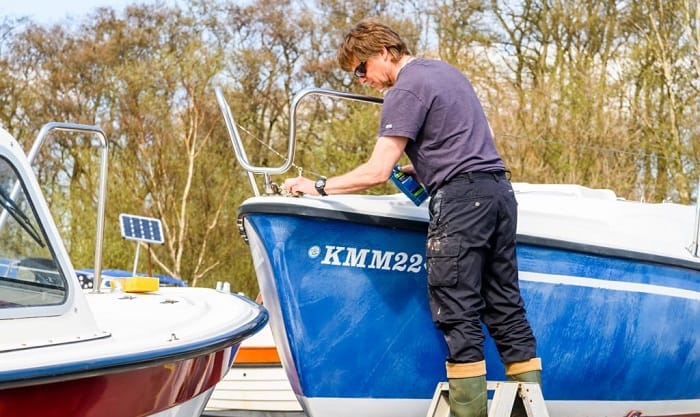When maintaining a boat, polishing is an important part of the job. But this brings up the matter of what to use, boat wax vs polish, which can be tricky to work out.
Wax gives excellent shine but wears off easily while marine polish gives less shine but additional protection. Let’s take a closer look at these boat maintenance options and find out what to do for our vessel.
Keep reading to learn more.
Table of Contents
Body
Different tools excel in different situations, and the same applies to marine polish vs wax. Each brings something different to the table. We’ll discuss the two below along with compounds.
Wax
When talking about wax, carnauba is the most well-known. It is made from the Brazilian palm tree, and different products contain different levels of wax. While there are other types available, carnauba is known to be the best one, and products with a higher concentration are usually better but more expensive.
Wax provides very good shine as well as protection against scratches and UV. However, it is known to wear off easily, especially in hot or tropical climates. Once it wears off, it loses both its shine and protection. Frequent application may also cause another problem: it often leads to surface damage that requires repair.
There are other types of the product as well, but these are mostly mixtures of wax and compound with varying ratios. Common ones are cleaner wax and restorer wax.
Compound
This is fine grit that is added to either wax or polish for use on different vehicle surfaces. When a boat’s surface has scratches or oxidation, using a compound will allow you to scrape off such deformities and discoloration.
The difference between cleaner wax and restorer wax is the amount of compound mixed into each. Cleaner wax has a limited amount of compound and is used for light scratches and oxidation. Restorer wax is a thicker mixture with a high level of compound, intended for use on heavily oxidized surfaces.
There are polishing compounds available as well with compounds mixed into marine polish instead.
Polish
This is an excellent alternative to wax that is capable of providing lasting UV protection in addition to making the surface shine. However, it is known to be difficult to apply properly, requiring a lot of time and effort.
By itself, polish is capable of handling light scratches, though be prepared to take extra time working on them. The advantage is that, unlike compounds, this won’t damage the boat’s surface. However, there are also different types of polish available, including ones with compounds, so make use of the one that is best for your situation.
Using Wax and Polish
To sum up, wax offers excellent shine and protection, but polish is better at providing the latter. Polish also clears out light scratches and restores some shine and color.
Compounds should be reserved for situations where oxidation and surface damage are too much for the polish to handle.
After reading what marine wax and polish have to offer, it is easier to imagine what types of situations they can be used for. However, many boaters opt to use both instead. Doing so provides the benefit of both and more.
Proper Boat Polishing
Here is one recommended polishing process making use of polish and wax. Prepare cleaning cloths, a rotary buffer, soap, and water for this as well.
1. Wash the boat
The first step is to wash the boat thoroughly. You can use specialized cleaners, but good old soap is enough. Take this time to inspect the surface as well to identify which sections need more work.
Wipe and dry the surface properly before proceeding.
2. Apply compound
The compound is applied after cleaning. Limit application to sections, as it will be easier to localize the work rather than rubbing the entire boat all at once. Be sure to read and follow product instructions carefully.
3. Use polish
As mentioned above, polish is capable of removing light scratches and oxidation, so skip compound if the boat surface doesn’t look too shabby.
While you can polish a boat by hand, it is recommended to use a rotary buffer to speed up the process. However, it’s important to note that it will still take a lot of time, even with a buffing machine.
You’ll know you’re almost done when the surface starts becoming shinier. You can buff a boat up to a certain level, but it’s the wax that will finish the job.
Check this guide to find how to use the buffer to wax your boat properly.
4. Finish with wax
Waxing a boat hull is the final step as it seals in the shine that polish gives along with providing additional luster. Once the wax wears off, you’ll still have the locked-in shine of the boat polish that will last longer.
However, there are different types of wax. Use one that is specialized for use with each surface material. When you wax fiberglass boat, there are types for that as well.
As an alternative, you can make use of a polishing kit that will provide you with a complete set of items for the whole process.
Conclusion
After reading through this guide, boat wax vs polish is all cleared up for you. More importantly, you know that they work best together.
If you have any comments or suggestions about this topic, feel free to drop them down below. We’d love to hear your thoughts or any experiences you’d like to share.
Remember to boat safely.

“My intention from the first day establishing Boating Basics Online is to provide as much help as possible for boaters who want to experience a first safe and convenient trip. So feel free to join us and share your beautiful journeys to the sea!”



